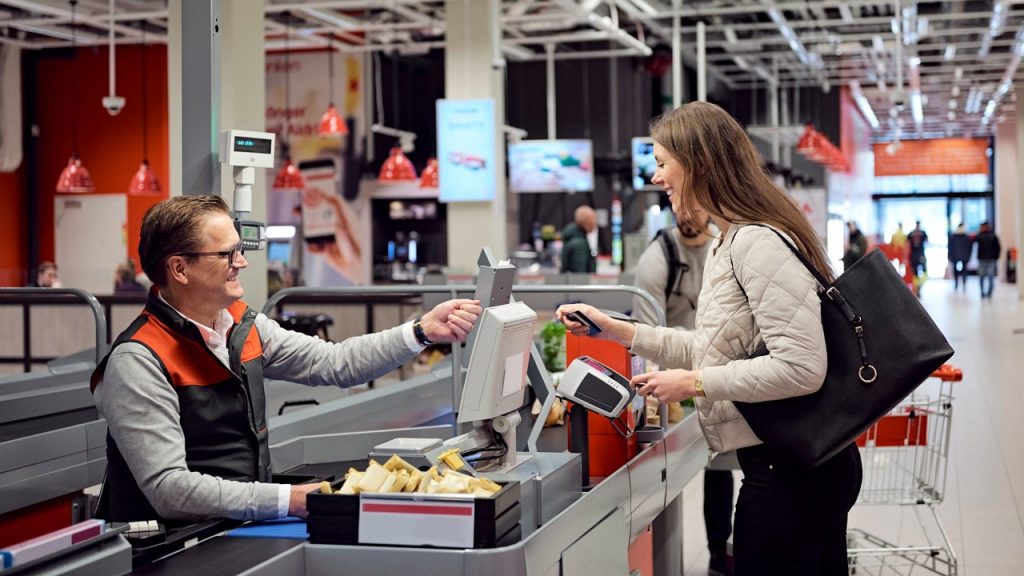Key takeaways
- While credit card issuers use merchant category codes to classify businesses, you may be able to leverage them to maximize your card’s rewards.
- Knowing the MCCs of stores you frequent can help you find which stores will reward you the most on your purchases.
- Retailers can have different MCCs than others in the same chain — a potential “loophole” to earning points or miles on purchases that typically don’t earn many rewards.
Digging into the inner workings of your credit card rewards might sound intimidating, but the extra elbow grease is worth it. For instance, exploring your card terms will reveal that you earn cash back based on the business’s merchant category code — or MCC.
This hidden knowledge can help you understand what makes your rewards program tick. Read on to learn the ins and outs of MCCs — and how you can use this knowledge to earn maximum rewards with your rewards credit card.
What is a merchant category code?
Merchant category codes are four-digit numbers that credit card networks — like Visa, Mastercard, American Express and Discover — use to classify businesses in order to track consumer spending. They collect this information to protect you from fraud, assign rewards and gather marketing data to fine-tune their products.
Here’s how you may see these categories appear in your credit card account:
On the flip side, you can also use this information to your benefit by performing a simple MCC code lookup. By analyzing your network’s merchant category code list prior to shopping, you can determine how to earn the most rewards according to your card’s bonus categories.
Keep in mind that each network has its own specific merchant category code list and definitions for which purchases or retailers qualify. For example, Discover’s MCCs are slightly different than the MCC codes for Visa.
Why didn’t I earn rewards on a purchase at a certain store?
Not earning elevated rewards on a purchase that you thought qualified in a bonus category typically boils down one of two things:
- Your rewards card’s bonus category definition
- Your network’s MCC classification
Some credit cards offer broader definitions for their bonus categories. For instance, the Chase Freedom Flex®* occasionally offers online shopping rewards at specific retailers — such as Amazon.com, Walmart and PayPal purchases — based on its quarterly cash back calendar. Meanwhile, the Bank of America® Customized Cash Rewards credit card has an in-depth online shopping category that covers a broad array of merchants — from major retailers to specialty merchants like Etsy.com.
Another reason you may have missed out on bonus rewards is that the credit card MCC didn’t correlate with the issuer’s bonus category. For example, standard Walmart locations are typically listed as MCC 5310 — or discount stores — while Walmart Supercenters are usually listed under Visa’s MCC 5411 — grocery stores and supermarkets. Similarly, many Costco fuel locations are listed as MCC 5542 — automated fuel dispensers — instead of MCC 5541 (like most traditional gas stations). Depending on the MCC credit card listing, bonus category descriptions can reduce rewards on these purchases.
These annoying MCC differences develop because the store’s merchant category code is determined by the primary products it sells. Since Walmart doesn’t primarily sell supermarket produce, its MCC reflects that.
How to find a merchant category code
Now that you know what an MCC code is, let’s talk about how to spot them. Finding a business’s merchant category code can be tricky depending on your network. Visa merchant category codes are generally easy to find since it’s the largest network. A quick Mastercard merchant category code lookup will also find you a list of Mastercard MCCs pretty easily.
However, American Express and Discover don’t make their code lists publicly available. In that case, your card issuer may provide a list of its network’s MCCs either online or by request.
If you don’t have a store’s exact MCC, it might take some trial and error to nail down which stores near you offer the best rewards. Try using your card to make a small purchase at the store you want to shop, then check your next statement to see how much you earned in rewards. This can help you determine how your credit card will code purchases from that store before you commit to spending a lot of money that won’t be coded to qualify for your card’s bonus categories.
Earning cash back with merchant category codes
Maximizing your cash back or other rewards begins with knowing the MCCs of the merchants you shop with most frequently. To help you get started, we’ve collected a list of the most common bonus categories and compared them to the Visa and Mastercard merchant category codes. Keep in mind that some merchant brands have their own MCCs, especially when it comes to travel chains.
| Cash back category | Visa MCC | Mastercard MCC |
| Groceries/U.S. supermarkets | 5411: Grocery stores and supermarkets | 5411: Grocery stores and supermarkets |
| Wholesale clubs | 5300: Wholesale clubs | 5300: Wholesale clubs |
| Superstores/Big box stores (Walmart, Target, etc.) | 5310: Discount stores | 5310: Discount stores |
| Gas stations | 5541: Service stations (with or without ancillary services) 5542: Automated fuel dispensers |
5541: Service stations (with or without ancillary services) 5542: Automated fuel dispensers |
| Restaurants/dining | 5812: Eating places and restaurants 5813: Drinking places (alcoholic beverages) — bars, taverns, nightclubs, cocktail lounges and discotheques 5814: Fast food restaurants |
5812: Eating places, restaurants 5813: Bars, cocktail lounges, discotheques, nightclubs and taverns — drinking places (alcoholic beverages) 5814: Fast food restaurants |
| Entertainment | Very broad, but here are a few popular examples: 7832: Motion picture theaters 7922: Ticket agencies and theatrical producers (except motion pictures) 7991: Tourist attractions and exhibits |
Very broad, but here are a few popular examples: 7832: Motion picture theaters 7922: Theatrical producers (except motion pictures), ticket agencies 7991: Tourist attractions and exhibits |
| Department stores | 5311: Department stores | 5311: Department stores |
| Online shopping | 5815 to 5818: Digital goods (including digital media, games, applications and “large digital goods merchants”) | These can vary depending on the merchant, but digital goods range from 5815 to 5818 |
| Drug stores | 5912: Drug stores and pharmacies | 5912: Drug stores and pharmacies |
| Home improvement | 5712: Furniture, home furnishings and equipment stores (except appliances) 5713 to 5714, 5718 to 5719 and 5722: Includes floor covering stores, drapery/upholstery stores, fireplace stores, household appliance stores and miscellaneous home furnishing specialty stores |
5712: Equipment, furniture and home furnishings stores (except appliances) 5713 to 5714, 5718 to 5719 and 5722: Includes floor covering stores, drapery/upholstery stores, fireplace stores, household appliance stores and miscellaneous home furnishing specialty stores |
| Travel | Very broad, but here are a few popular examples: 3000 to 3308: Individual airline MCCs 4511: Airlines and air carriers (not elsewhere classified) 4582: Airports, flying fields and airport terminals 3351 to 3441: Car rental agencies 3501 to 3839: Lodging — hotels, motels, resorts7011: Lodging — hotels, motels, resorts and central reservation services (not elsewhere classified) 4111: Local and suburban commuter passenger transportation, including ferries 4121: Taxicabs and limousines 4131: Bus lines 4784: Tolls and bridge fees 4112: Passenger railways 4411: Steamship and cruise lines 4722: Travel agencies and tour operators |
Very broad, but here are a few popular examples: 3000 to 3350: Airlines and air carriers 4511: Air Carriers, airlines (not elsewhere classified) 4582: Airports, airport terminals, flying fields 3351 to 3500: Car rental agencies 3501 to 3999: Lodging — hotels, motels, resorts 7011: Lodging — hotels, motels and resorts (not elsewhere classified)4111: Transportation — suburban and local commuter passenger, including ferries 4121: Limousines and taxicabs 4131: Bus lines 4784: Bridge and road fees, tolls 4112: Passenger railways 4411: Cruise lines 4722: Travel agencies and tour operators |
In the end, it is at the discretion of your card issuer which MCCs they will lump into your bonus category. Not all cards with a travel bonus will consider passenger railways, for instance.
How to maximize your rewards with merchant category codes
Now that you have a general understanding of bonus category codes, here are a few strategies to align your spending and maximize your rewards card’s categories.
Know your favorite stores’ merchant category codes
The first step to optimizing your spending is to determine the MCCs of the stores you frequently shop at. Investing a little bit of time into finding the store that rewards you the most can deliver an excellent return with cash back.
To get started, simply do an MCC code lookup and determine how you think purchases at a certain store may be coded. Then, make a small purchase to see if your purchase codes the way you think it will.
During the process, you might find that some stores in the same chain may have different MCCs, depending on their primary inventory. Even different counters or sections in the same department store may carry different MCCs. You can use this to your advantage if you know one location near you will provide a better cash back rate than the other.
Keep your shopping within your best rewards category
It may take some extra work, but try doing most of your shopping at stores that are coded within your card’s largest rewards category.
For instance, the Ink Business Cash® Credit Card earns 5 percent cash back on office supply story purchases (up to $25,000 spent per year, then 1 percent). However, if your office supply store allows you to purchase gift cards to other stores, you can use Ink Cash to essentially earn 5 percent cash back at other retailers, too.
Keep in mind. Some issuers, including American Express, officially state that you cannot earn rewards on the purchase of gift cards.
Get creative with your shopping
As mentioned, some store locations will have different MCCs than the others in the same chain — some of which may come as a nice surprise. These “loopholes” can provide great opportunities to reap rewards on purchases that typically wouldn’t earn elevated rewards.
For example, you may be able to find a retail store that codes as a drugstore purchase. This means the Chase Freedom Unlimited® card may earn 3 percent cash back on what would normally be considered a discount or department store purchase. Simply check your rewards statement later to see if your creativity was rewarded or if the “loophole” was closed.
The bottom line
Sifting through your credit card’s MCC classifications might sound overwhelming, but these valuable specifications can be worth their weight in rewards opportunities.
Once you understand your favorite stores’ MCCs, you can optimize your shopping list for boosted rewards on purchases that normally wouldn’t earn anything more than the base rewards rate. With a little elbow grease and creativity, you’ll be laughing all the way to the bank.
*Information about the Chase Freedom Flex® has been collected independently by Bankrate. The card details have not been reviewed or approved by the card issuer. The
Bank of America content in this post was last updated on Dec. 4, 2024.
Frequently asked questions (FAQs)
Read the full article here










